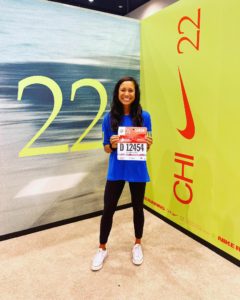Proximal Hamstring Tendinopathy Success Story: Arthi’s Journey
Meet Arthi
Name: Arthi Age: 33 Location: Colorado, near Denver
Arthi, our featured guest today, shares her experience battling proximal hamstring tendinopathy, her journey, and the valuable insights she’s gained along the way.
Initial Hamstring Symptoms and Running Background
Arthi’s PHT journey began when she was training for her 14th marathon in September 2021. As a seasoned marathoner, she noticed something unusual during her long training runs – a persistent pulling sensation at the top of her hamstring. It felt different from any previous running injuries she had encountered. This discomfort emerged in the final 20-mile training runs leading up to the marathon.
Upon reflection, Arthi realized that several factors may have contributed to the onset of her hamstring tendinopathy. She had been easing back into long-distance running post-COVID, pushing her mileage and consistency but neglecting the crucial element of recovery, including rest days.
Seeking Early Tendinopathy Treatment
Initially, Arthi assumed the issue was merely tightness and tried common remedies like stretching, foam rolling, and attending more yoga classes. However, her symptoms persisted and even worsened. Concerned about her upcoming marathon, she sought help from a physical therapist who diagnosed her with probable upper hamstring tendinitis. While the therapist cleared her to run the marathon, Arthi knew that her condition required further attention.
After the marathon, Arthi’s pain intensified, and she faced discomfort when sitting for extended periods. She decided to take her recovery into her own hands and started researching her condition. This quest for knowledge led her to discover resources like the overcoming proximal hamstring tendinopathy podcast.
The Role of Strength Training
One of the critical insights Arthi gained was the importance of strength training, a component she had previously overlooked in her running routine. She realized that as she aged and accumulated marathon experience, strength training became essential to her overall fitness and resilience against injuries. Exercises like glute bridges, single-leg glute bridges, hamstring curls, and single-leg deadlifts became staples in her rehabilitation routine.
Arthi’s journey involved gradual progression in both strength and running. She started with lower mileage and a walk-run strategy to reintroduce running safely. Her physical therapist helped create a structured plan to avoid overloading her healing tendon.
Managing Proximal Hamstring Tendinopathy Flare-Ups
Arthi observed a pattern where her flare-ups often occurred after nights of poor sleep, high stress levels, or when she pushed too hard with speed during her runs. She learned to recognize these triggers and adjust her training accordingly. It became clear that managing her sleep, stress, and running intensity played a crucial role in managing her PHT.
 The Boston Marathon Experience
The Boston Marathon Experience
On the day of the Boston Marathon, Arthi had some concerns about how her hamstring would respond, given that she hadn’t run a marathon in a while. However, she was pleasantly surprised by her performance. Despite not focusing on speed or hill training due to her condition, she completed the marathon in three hours and 32 minutes, a testament to her determination and dedication.
Recovery and Future Plans
Following the marathon, Arthi took a 10-day break from running to recover and engaged in swimming and walking for cross-training. Her recovery was notably better than after her previous marathons. While she still experiences occasional discomfort, she plans to continue her strength training and gradually increase her running intensity. Her goal is to keep her hamstring strong and continue running marathons.
Key Takeaways for Proximal Hamstring Tendinopathy Sufferers
Arthi’s journey offers several valuable takeaways for individuals dealing with Proximal Hamstring Tendinopathy:
1. Consistent Strength Training for the Hamstrings
Make strength exercises a consistent part of your routine, even when you’re feeling better. Exercises like glute bridges and deadlifts are essential for preventing and managing PHT.
2. Patience and Discipline with Tendon recovery
Be patient with yourself and your body’s healing process. Avoid setting unrealistic timelines for recovery. Consistency and discipline in strength training and management are key.
3. Maintain Hope
Believe in your body’s ability to heal. Stay positive and maintain hope that you will overcome PHT. Avoid dwelling on negative stories and focus on your own journey to recovery.
Arthi’s story is a testament to the power of persistence, discipline, and a positive mindset in managing PHT. While the road to recovery may have its ups and downs, with the right approach and determination, runners like Arthi can continue pursuing their passion for marathon running despite facing this challenging condition.



 The Boston Marathon Experience
The Boston Marathon Experience